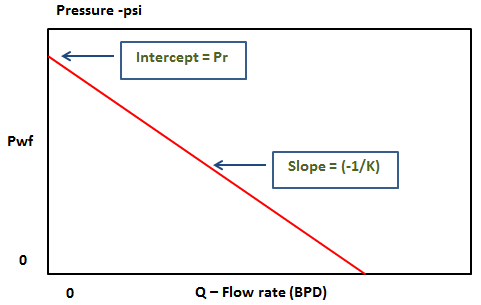The productivity of the well depends on an efficient use of the compressional energy available in the reservoir allowing the reservoir fluids to flow toward the production separator. As an introduction to IPR and VLP, this article will introduce two key relationships (IPR and VLP) used in the design of the production system.
Introduction to IPR and VLP:
- Inflow Performance Relationship (IPR) is defined as the well flowing bottom-hole pressure (Pwf) as a function of production rate. It describes the flow in the reservoir. The Pwf is defined in the pressure range between the average reservoir pressure and atmospheric pressure. A typical inflow performance relationship is presented in the following graph:

The intersection of the PI plot with the x-axis is the flow rate corresponding to a Pwf equal to zero. This point in the IPR plot is known as the Absolute Open Flow (AOF) potential of the well.
The following video shows more details about reservoir inflow performance:
- Vertical Lift Performance Relationship (VLP), named also Outflow, describes the bottom-hole pressure as a function of flow rate. The VLP depends on many factors including fluid PVT properties, well depth, tubing size, surface pressure, water cut and GOR. It describes the flow from the bottom-hole of the well to the wellhead.

Both the Inflow Performance Relationship and the Vertical Lift Performance Relationship relate the wellbore flowing pressure to the surface production rate. While the IPR represents what the reservoir can deliver to the bottom hole, the VLP represents what the well can deliver to the surface.

The intersection of the IPR with the VLP, called the operating point, yields the well deliverability, an expression of what a well will actually produce for a given operating condition (Pr, PI, WC, GOR, THP, Tubing size…).





